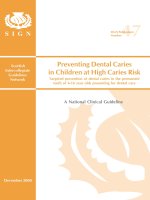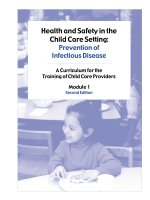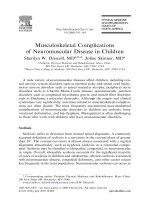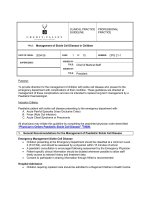Flouride in prevention of dental caries in children
Bạn đang xem bản rút gọn của tài liệu. Xem và tải ngay bản đầy đủ của tài liệu tại đây (920.44 KB, 20 trang )
Flouride in Prevention of Dental
Caries in Children
Odonto-stomatology
DENTAL CARIES
Chronic infectious
diseases.
Transmissible
Bacterial by-products
(acids) dissolve the
enamel of teeth.
DENTAL CARIES
Bacteria
Carbohydrates
Tooth
CARIE
Time
FLOURIDES and DENTAL CARIES
Better oral
hygiene
Carbohydrates
Bacteria
Reduce
Dietary
Challenge
Tooth
Better
use of
Flouride
Nutrition
FLOURIDES
Fluoride is the ionic form of the element fluorine.
It is negatively charged and will not remain as a free
element.
Fluoride has a high affinity for calcium.
very compatible with teeth and bone.
FLOURIDES
Fluoride has been available in the United States since
the mid-1940’s.
In 2008, 64.3% of the population served by public
water systems received optimally fluoridated water.
There is strong evidence that community water
fluoridation is effective in preventing dental caries.
FLOURIDES
Prevents demineralization.
Enhances remineralization.
Alters the action of plaque bacteria.
Systemic Sources of Fluoride
Drinking water
Foods
Toothpaste
Fluoride supplements
Topical Sources of Fluoride
Toothpaste
Fluoride mouthrinses
Fluoride gels
Fluoride varnish
CONCLUSION
All sources of fluoride must be considered.
Supplementation:
children at high risk of developing caries
when fluoride access is limited.
Not supplementation:
children younger than 6 months and older than 16 years.
adequate fluoridated community water.
References
1. American Academy of Pediatric Dentistry. Guideline on Infant Oral Health Care.
Council on Clinical Affairs. Reference Manual 2011. 33(6): 124-128.
2. American Academy of Pediatric Dentistry. Policy on Early Childhood Caries (ECC):
Classifications, Consequences, and Preventive Strategies. Pediatr Dent 2011, 33(6):
47-49.
3. American Dental Association Council on Scientific Affairs. Professionally applied
topical fluoride. Evidence-based clinical recommendations. JADA. August 1, 2006.
137(8): 1151-1159.
4. Berg J, Gerweck C, Hujoel PP, et al. Evidence-Based Clinical Recommendations
Regarding Fluoride Intake from Reconstituted Infant Formula and Enamel Fluorosis. A
Report of the American Dental Association Council on Scientific Affairs. JAMA. January
2011 vol. 142(1): 79-87.
5. Centers for Disease Control and Prevention. Recommendations for using fluoride to
prevent and control dental caries in the United States. MMWR. 2001; 50(RR-14): 1-42.
Available online at: />Accessed November 20, 2006.
References, continued
6. Centers for Disease Control and Prevention. Surveillance for Dental caries, Dental
sealants, Tooth Retention, Edentulism, and Enamel Fluorosis-United States, 1988-1994
and 1999-2002. MMWR Surveillance Summaries. 2005. 54(03);1-44. Available online
at: Accessed November
20, 2006.
7. Centers for Disease Control and Prevention. Using Fluoride to Prevent and Control
Tooth Decay in the United States Fact Sheet, updated Jan 2011.
www.cdc.gov/fluoridation/fact_sheets/fl_caries.htm
8. Department of Health and Human Services. HHS Recommendation for Fluoride
Concentration in Drinking Water for Prevention of Dental Caries. Federal Register. Vol.
76(9): January 13, 2011.
9. Krol DM. Dental caries, oral health, and pediatricians. Curr Probl Pediatr Adolesc
Health Care. 2003; 33(8):253-270.
10. Lewis CW, Milgrom P. Fluoride. Pediatr Rev. 2003; 24(10):327-336.
11. Lewis DW, Ismail AI. Periodic health examination: 1995 update: 2. Prevention of
dental caries. The Canadian Task Force on the Periodic Health Examination. Can Med
Assoc J. 1995; 152(6): 836-46.
THANK FOR YOUR ATTENTION!









